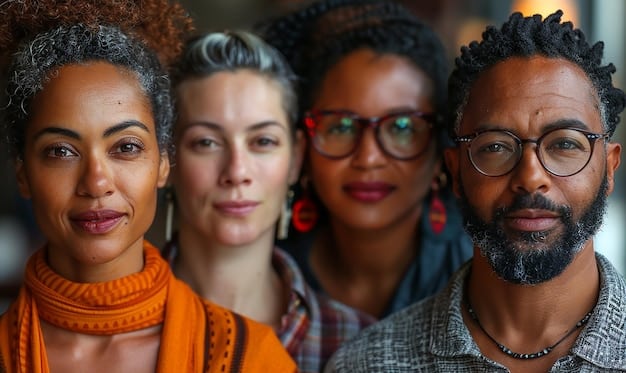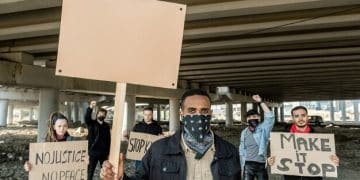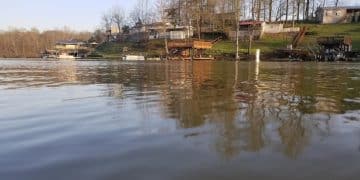Climate Change Impact: Understanding Marginalized Communities in the US

Understanding the disproportionate impact of climate change on marginalized communities in the US requires examining socio-economic vulnerabilities, historical injustices, and the need for targeted mitigation strategies that prioritize equity and resilience for these populations.
Understanding the disproportionate impact of climate change on marginalized communities in the US: What Mitigation Strategies Are Needed? is crucial for crafting equitable and effective climate policies that address the unique vulnerabilities faced by these communities.
Unveiling Climate Change’s Unequal Burden
Climate change is not just an environmental issue; it’s a social justice issue that exacerbates existing inequalities. Marginalized communities, including low-income neighborhoods, communities of color, and indigenous populations, often bear the brunt of climate change impacts due to factors like geographic location, historical discrimination, and limited access to resources.
These communities frequently reside in areas more susceptible to environmental hazards such as flooding, extreme heat, and air pollution. The effects of climate change, such as increased frequency and intensity of natural disasters, further strain their already limited resources and coping capacities.

Why Marginalized Communities Are More Vulnerable
Several factors contribute to the increased vulnerability of marginalized communities to climate change. Understanding these factors is essential for developing targeted and effective mitigation and adaptation strategies.
Socio-Economic Factors
Poverty and lack of economic opportunity significantly limit the ability of individuals and communities to prepare for and recover from climate-related disasters. Limited access to healthcare, insurance, and financial resources further compounds their vulnerability.
Historical Injustices and Systemic Discrimination
Historical patterns of segregation, redlining, and discriminatory housing policies have often concentrated marginalized communities in areas with higher environmental risks and limited access to essential services. These historical injustices continue to shape current vulnerabilities.
- Environmental Racism: The disproportionate exposure of communities of color to environmental hazards and pollutants.
- Lack of Political Representation: Limited influence in decision-making processes related to climate policy and resource allocation.
- Infrastructure Deficiencies: Aging or inadequate infrastructure in marginalized communities increases their susceptibility to climate impacts.
Addressing these underlying vulnerabilities requires a holistic approach that integrates climate action with social and economic justice initiatives.
The Devastating Effects of Climate Change
Climate change manifests in various ways, each with distinct and severe impacts on marginalized communities. These effects can range from immediate threats to long-term challenges that undermine community well-being.
Increased Frequency and Intensity of Natural Disasters
Marginalized communities are often disproportionately affected by hurricanes, floods, wildfires, and other extreme weather events. These disasters can lead to displacement, loss of property, and long-lasting trauma.
Health Impacts
Climate change exacerbates existing health disparities, leading to increased rates of respiratory illnesses, heatstroke, and infectious diseases. Marginalized communities often lack access to quality healthcare, making them even more vulnerable to these health impacts.
- Air Pollution: Increased levels of air pollution from wildfires and industrial sources contribute to respiratory problems.
- Water Contamination: Flooding and saltwater intrusion can contaminate water supplies, leading to waterborne diseases.
- Food Insecurity: Climate change impacts on agriculture can lead to food shortages and increased food prices.
Addressing these impacts requires comprehensive strategies that prioritize public health, disaster preparedness, and community resilience.

Mitigation Strategies That Center Equity
Effective mitigation strategies must prioritize equity and justice, ensuring that the benefits of climate action are shared by all members of society, particularly those most vulnerable to climate impacts.
Community-Led Solutions
Empowering marginalized communities to develop and implement their own climate solutions is essential. These solutions should be tailored to local needs and priorities, reflecting the unique knowledge and experiences of community members.
Investing in Resilient Infrastructure
Prioritizing investments in resilient infrastructure in marginalized communities can help protect them from climate impacts. This includes upgrading water and sanitation systems, strengthening transportation networks, and constructing energy-efficient buildings.
- Green Infrastructure: Implementing green infrastructure solutions, such as urban forests and green roofs, can help mitigate the urban heat island effect and improve air quality.
- Renewable Energy: Expanding access to affordable renewable energy can reduce energy costs and create jobs in marginalized communities.
- Energy Efficiency: Promoting energy efficiency measures in homes and businesses can lower energy consumption and reduce greenhouse gas emissions.
By centering equity in mitigation efforts, we can create a more just and sustainable future for all.
Policy Recommendations for a Just Transition
To effectively address the disproportionate impact of climate change on marginalized communities, policymakers must implement comprehensive and equitable policies that prioritize their needs and promote a just transition to a low-carbon economy.
Strengthening Environmental Regulations
Enforcing and strengthening environmental regulations can help reduce pollution and protect marginalized communities from environmental hazards. This includes addressing issues such as air quality, water contamination, and toxic waste disposal.
Investing in Climate Resilience Planning
Providing resources and support for marginalized communities to develop climate resilience plans is crucial. These plans should identify vulnerabilities, assess risks, and outline strategies for adaptation and mitigation.
- Community Engagement: Ensuring that community members are actively involved in the planning process.
- Equitable Resource Allocation: Prioritizing funding for projects that benefit marginalized communities.
- Data-Driven Decision-Making: Using data and research to inform policy decisions.
By implementing these policy recommendations, we can create a more equitable and resilient society that protects the most vulnerable from the impacts of climate change.
The Role of Advocacy and Community Organizing
Advocacy and community organizing play a vital role in advancing climate justice and ensuring that the voices of marginalized communities are heard. These efforts can help raise awareness, mobilize support, and hold policymakers accountable.
Building Coalitions
Forming coalitions between community organizations, environmental groups, and social justice advocates can amplify their collective impact. These coalitions can work together to advocate for policy changes, organize campaigns, and raise awareness about climate justice issues.
Empowering Youth Voices
Engaging youth in climate advocacy and organizing is essential. Young people are often the most passionate and effective advocates for change, and their voices must be amplified in decision-making processes.
- Education and Training: Providing youth with the knowledge and skills they need to become effective advocates.
- Mentorship Opportunities: Connecting youth with experienced advocates and community leaders.
- Creating Platforms for Youth Voices: Providing opportunities for youth to share their stories and perspectives.
By supporting advocacy and community organizing efforts, we can create a powerful movement for climate justice that is led by and accountable to marginalized communities.
| Key Point | Brief Description |
|---|---|
| 🌍 Climate Inequity | Marginalized groups face greater climate change risks. |
| 🛡️ Resilience | Boosting community resilience is vital via local leadership. |
| 🌱 Sustainable Policies | Policies promoting sustainability must serve all. |
| 🤝 Community Unity | Coordination is key in facing climate challenges. |
Frequently Asked Questions (FAQs)
▼
Marginalized communities often reside in areas vulnerable to climate impacts, lack adequate resources, and face systemic barriers that hinder their ability to prepare for and recover from climate-related events.
▼
Climate justice recognizes that climate change disproportionately affects marginalized communities and seeks to address these inequities by ensuring that climate policies and actions are fair and equitable.
▼
Mitigation strategies include reducing greenhouse gas emissions through renewable energy, improving energy efficiency, and implementing sustainable transportation systems. Investing in green infrastructure is also key.
▼
Communities can build resilience by investing in infrastructure upgrades, developing emergency response plans, promoting community engagement, and ensuring access to essential resources like healthcare and insurance.
▼
Advocacy plays a crucial role by raising awareness, mobilizing support, and holding policymakers accountable for implementing climate policies that prioritize equity and justice for all communities.
Conclusion
Addressing the disproportionate impact of climate change on marginalized communities in the US requires a multifaceted approach that integrates climate action with social and economic justice initiatives. By prioritizing equity, empowering communities, and implementing comprehensive policies, we can create a more just and sustainable future for all.





